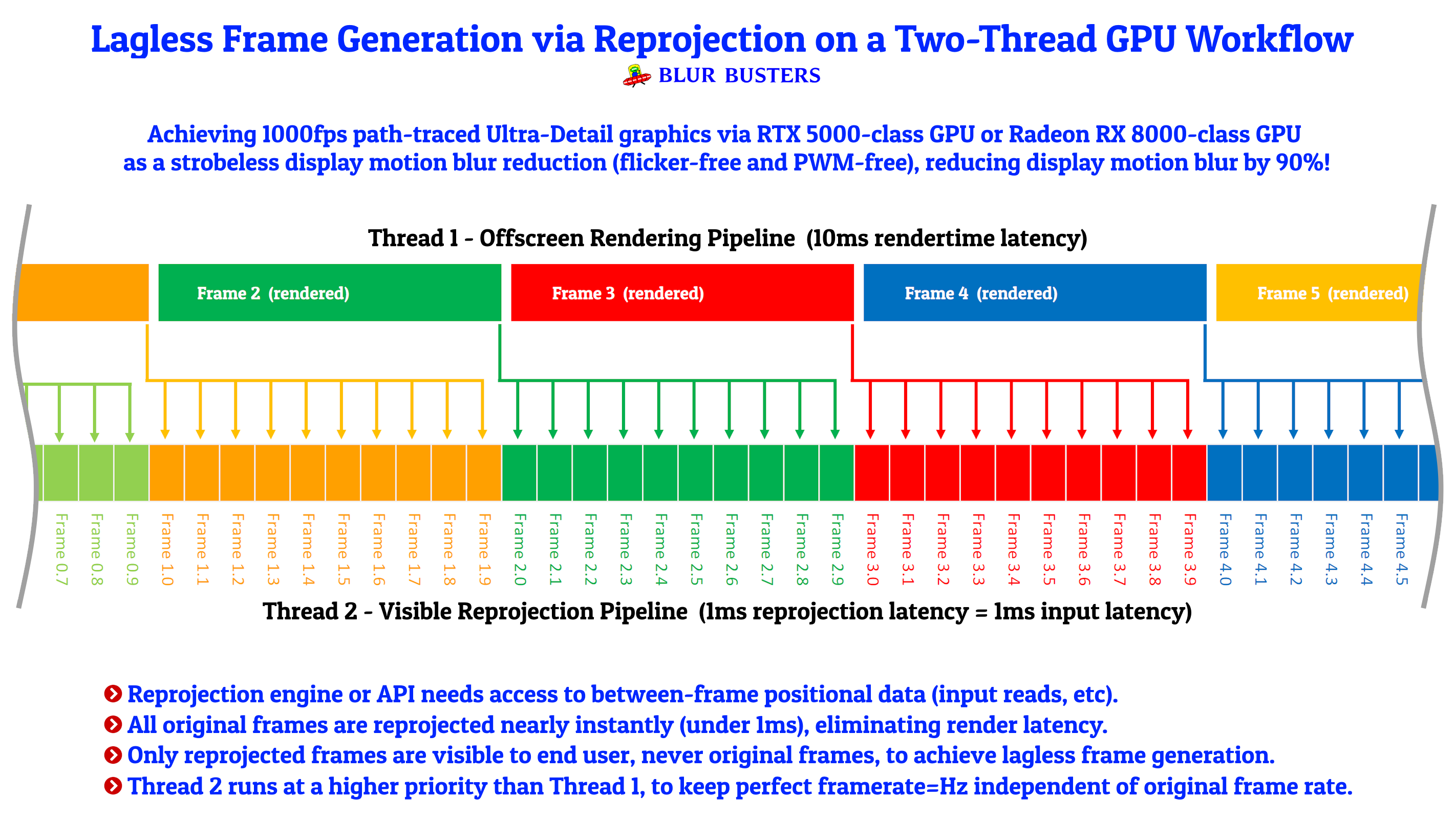DLSS3 interpolation two-cap approach ("latency guard" in-game cap + "stutter guard" external cap)
Posted: 15 Jul 2023, 03:10
We've gotten new information that DLSS3 interpolation creates weird behaviors with frame rate caps, but we've discovered "Best Practices".
1. In-game frame rate caps perform lowest latency with DLSS 3.
2. Few games support capping during DLSS 3 interpolation, e.g. Cyberpunk2077 and Witcher.
3. If you are having capping problems, use half-cap numbers to account for DLSS 3.0 interpolation.
- You have to do this with Cyberpunk 2077 when enabling DLSS interpolation, as that's pre-interpolation frame rate.
3. For most in-game cap with DLSS 3.0, use a frame rate less than half the max Hz.
- For example for a 120Hz OLED G-SYNC television, you want about a 55fps (110fps) in-game cap (110fps after DLSS 3 interpolation), and about a 57fps (114fps) external cap.
4. Use the two-tier cap approach to reduce latency and stutters simultaneously.
- "Latency guard" cap is the in-game cap, set slightly lower
- "Stutter guard" cap is the external cap (e.g. RTSS or Drivers or Reflex), set slightly higher but still generates post-interpolation frame rates below GSYNC Max-Hz.
The fallback cap only responsibility is to catch those rascal frametimes not successfully caught by the in-game cap (lower lag), to prevent stutters from appearing. That's why I now call them the internal "latency guard" cap and the separate external "stutter guard" cap.
6. Most of your interpolation lag disappears AND most of your stutters disappear!
It's a massively better DLSS 3.0 interpolation experience in Cyberpunk 2077 with a lot less lag. Still some, but much less laggy.
The two-tier cap approach REALLY works in some games! Not all, and you have to make sure your in-game framerate cap is less than the Reflex cap, if you're using NVIDIA Reflex, otherwise there's nasty interactions. Or just disable Reflex and use simple driver/RTSS cap, for the specific game. Experiment. It's the Wild West of frame generation.
Someday, frame generation will be lagless -- www.blurbusters.com/framegen
1. In-game frame rate caps perform lowest latency with DLSS 3.
2. Few games support capping during DLSS 3 interpolation, e.g. Cyberpunk2077 and Witcher.
3. If you are having capping problems, use half-cap numbers to account for DLSS 3.0 interpolation.
- You have to do this with Cyberpunk 2077 when enabling DLSS interpolation, as that's pre-interpolation frame rate.
3. For most in-game cap with DLSS 3.0, use a frame rate less than half the max Hz.
- For example for a 120Hz OLED G-SYNC television, you want about a 55fps (110fps) in-game cap (110fps after DLSS 3 interpolation), and about a 57fps (114fps) external cap.
4. Use the two-tier cap approach to reduce latency and stutters simultaneously.
- "Latency guard" cap is the in-game cap, set slightly lower
- "Stutter guard" cap is the external cap (e.g. RTSS or Drivers or Reflex), set slightly higher but still generates post-interpolation frame rates below GSYNC Max-Hz.
The fallback cap only responsibility is to catch those rascal frametimes not successfully caught by the in-game cap (lower lag), to prevent stutters from appearing. That's why I now call them the internal "latency guard" cap and the separate external "stutter guard" cap.
6. Most of your interpolation lag disappears AND most of your stutters disappear!
It's a massively better DLSS 3.0 interpolation experience in Cyberpunk 2077 with a lot less lag. Still some, but much less laggy.
The two-tier cap approach REALLY works in some games! Not all, and you have to make sure your in-game framerate cap is less than the Reflex cap, if you're using NVIDIA Reflex, otherwise there's nasty interactions. Or just disable Reflex and use simple driver/RTSS cap, for the specific game. Experiment. It's the Wild West of frame generation.
Someday, frame generation will be lagless -- www.blurbusters.com/framegen

